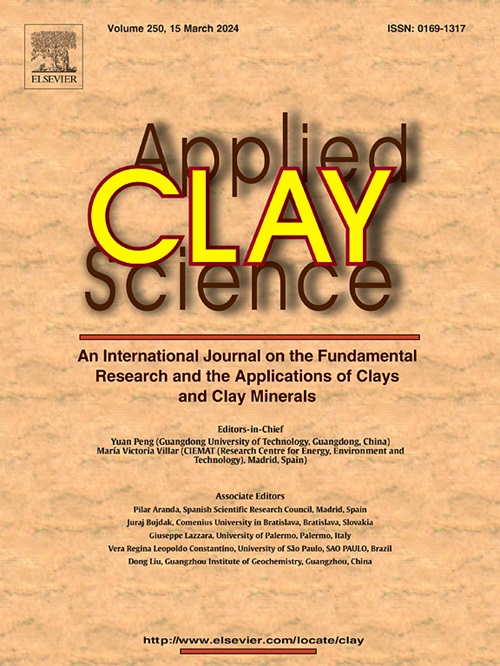Enhancing illitic-clay geopolymer production: A comparative study of conventional method and mechanosynthesized pre-geopolymer powder
IF 5.3
2区 地球科学
Q2 CHEMISTRY, PHYSICAL
引用次数: 0
Abstract
This study investigates the development of an environmentally sustainable production process for clay-based geopolymers. An illitic clay (IC) sourced from the Fes-Morocco region served as the aluminosilicate precursor after calcination (CIC), which was then activated using an alkaline mix (AM) composed of potassium hydroxide (KOH) and sodium silicate (SS). The pre-geopolymer powders (PGP) were generated by dry-mixing of milled CIC powders with alkaline activators, using various mass ratios of IC/AM and SS/KOH. This mixture underwent milling for brief durations of 3 and 5 min at 400 rpm, employing a planetary ball mill device. The resulting PGP was subsequently hydrated with water to form geopolymer pastes (MGP), which were then cured at 20 °C and 50 % relative humidity. Geopolymer pastes, prepared conventionally using the same mixture design (with a liquid form of sodium silicate) and curing conditions, were also included for comparative analysis of rheological, structural, and mechanical properties with the mechanosynthesized counterparts. The results of the study revealed that the mechanosynthesis process induced significant changes in the properties of the produced geopolymers. X-ray diffraction (XRD) analysis indicated a transformation in mineralogical composition towards amorphization, which is crucial for the formation of the desired Sodium-aluminium-silicate-hydrate(NASH) geopolymer network. Rietveld quantification further confirmed this by highlighting an increase in amorphous content and a decrease in crystalline phase content in the pre-geopolymer samples. Mechanosynthesized geopolymers with higher yield stress and storage modulus showed superior mechanical properties. Moreover, strain sweep analysis revealed greater stiffness and resistance to deformation in mechanosynthesized geopolymers compared to the conventional ones. Finally, compressive strength tests showed that mechanosynthesized geopolymers achieved significantly higher strengths than the conventionally prepared geopolymers, reaching up to 64 MPa after 28 days of curing. This result underscores the efficacy of mechanosynthesis in enhancing geopolymer properties.
提高伊利粘土地聚合物产量:常规方法与机械合成预地聚合物粉末的比较研究
本研究探讨了一种环境可持续的粘土基地聚合物生产工艺的发展。来自Fes-Morocco地区的一种粘土(IC)作为煅烧后的硅酸铝前驱体(CIC),然后使用由氢氧化钾(KOH)和硅酸钠(SS)组成的碱性混合物(AM)进行活化。采用不同质量比的IC/AM和SS/KOH,将CIC粉与碱性活化剂干混制备预地高聚物粉末(PGP)。采用行星球磨机装置,在400转/分的转速下对混合物进行3到5分钟的研磨。得到的PGP随后与水水合形成地聚合物糊状物(MGP),然后在20°C和50%相对湿度下固化。采用相同的混合物设计(水玻璃的液体形式)和固化条件制备的地聚合物浆料也被包括在内,与机械合成的浆料进行流变学、结构和机械性能的比较分析。研究结果表明,机械合成过程引起了所制地聚合物性质的显著变化。x射线衍射(XRD)分析表明,矿物组成向非晶化转变,这对于形成所需的钠-铝-硅酸盐水合物(NASH)地聚合物网络至关重要。Rietveld定量进一步证实了这一点,突出了非晶态含量的增加和前地聚合物样品中结晶相含量的减少。机械合成的地聚合物具有较高的屈服应力和储存模量,表现出优异的力学性能。此外,应变扫描分析表明,与传统的地质聚合物相比,机械合成的地质聚合物具有更大的刚度和抗变形能力。最后,抗压强度测试表明,机械合成的地聚合物的强度明显高于常规制备的地聚合物,固化28天后强度达到64 MPa。这一结果强调了机械合成在提高地聚合物性能方面的功效。
本文章由计算机程序翻译,如有差异,请以英文原文为准。
求助全文
约1分钟内获得全文
求助全文
来源期刊

Applied Clay Science
地学-矿物学
CiteScore
10.30
自引率
10.70%
发文量
289
审稿时长
39 days
期刊介绍:
Applied Clay Science aims to be an international journal attracting high quality scientific papers on clays and clay minerals, including research papers, reviews, and technical notes. The journal covers typical subjects of Fundamental and Applied Clay Science such as:
• Synthesis and purification
• Structural, crystallographic and mineralogical properties of clays and clay minerals
• Thermal properties of clays and clay minerals
• Physico-chemical properties including i) surface and interface properties; ii) thermodynamic properties; iii) mechanical properties
• Interaction with water, with polar and apolar molecules
• Colloidal properties and rheology
• Adsorption, Intercalation, Ionic exchange
• Genesis and deposits of clay minerals
• Geology and geochemistry of clays
• Modification of clays and clay minerals properties by thermal and physical treatments
• Modification by chemical treatments with organic and inorganic molecules(organoclays, pillared clays)
• Modification by biological microorganisms. etc...
 求助内容:
求助内容: 应助结果提醒方式:
应助结果提醒方式:


